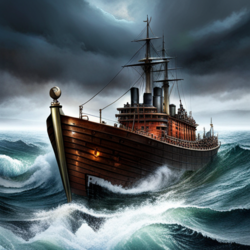Strait of Haifa
| The Strait of Haifa The Eastern Vine / The Great Vine | |

| |
| Location | Eastern Keltia |
| Coordinates | |
| Type | Rift Valley |
| Native Name | Misc. |
| Basin Countries | Alperkin, Bassarids, Natopia, Jezeraah, Imperial Federation |
| Minimum Width | 43.2 km |
| Maximum Width | 384 km (Lake Morovia) |
| Islands | |
| Settlements | |
| Abbreviation | SoH |
The Strait of Haifa, otherwise known as the Vine of Keltia or the Eastern Vine, is the narrow, elongated, shallow sea which separates central and eastern Keltia. The Strait is situated between longitudes 100E and 130E, and latitudes 20N and 70N.
Today the Strait of Haifa is dominated by commerce between the states which constitute the Maritime Markets of the Strait of Haifa. With that said, piracy is extremely common in the region, especially in regions which lie to the south of Lake Morovia.
Countries which have claimed territory bordering the Sea of Storms include: the Haifo-Pallisican Imperial Trade Union, Alperkin and Natopia, and most recently, the Imperial Federation.
Geology
The Strait of Haifa is a dormant continental rift zone in eastern Keltia which was formed when the East Keltian Continental Plate diverged from the Laceran and Caledonian plates.
Southern Strait of Haifa
The Southern Strait of Haifa lies to the south of Lake Morovia, and connects Lake Morovia to the Corprian Ocean. In terms of climate, the Southern Strait of Haifa is hot and semi-arid or arid. To that extent, the region's southernmost reaches lie within the bitterly hot Eastern Mykonos, and the rocky Thalassapolis deserts. In addition to its harsh, unforgiving climate, the Southern Strait of Haifa is home to a large number of very powerful pirate communities which operate out of the Port of Blore Heath. Most notable of these communities is the Bacchian Vine Fleet, a band of pirates who sail upon ships made from living vines, who - like most of the religious communities along the Strait of Haifa - worship the god of wine and ritual madness.
Major active cities along the Southern Strait of Haifa leading to the 1700's include Blore Heath, Mylecia, and Jogi. Inactive, or independent city-states include Fort Itainen, Bursesti, Newstone, Lewisburg, and Nouvelle Geneve. These latter cities are especially vulnerable to attack by pirates, such as those mentioned above, as well as by the giant fishermen who inhabit the coastal shore-lines of the Thallasopois Desert, who sometimes take exception to the high commercial traffic in the region, which is known to disrupt their efforts to catch the whales, sharks, and dolphins on which they subsist. These myriad challenges resulted in a relative, protracted decline in the number of independent city-states along the Southern Strait. Eventually, the Imperial Federation took limited control of the inland portions of the Strait near Lake Moravia and the southern Keltian coastline from 1718 AN.
The Southern Strait is regarded as the birthplace of Bassaridianism.
Lake Morovia

Despite its name, and its depiction on most official maps as a lake, Lake Morovia is not a lake but a vast swampland which sits in the heart of an ancient, dormant super-volcano. With that said, Lake Morovia is a large body of fresh water which drains directly into the briny Strait of Haifa. Accessible in only certain locations to large sea-going vessels, Lake Morovia is a foreboding land of twisting waterways and wetlands which has historically served as the home of notable nations such as Ocia and Haifa. Located in the center of the temperate climate region known as the Valley of Haifa, Lake Morovia is a region rife with Haifan pirates who derive inspiration from the adventures of Captain Ismael Hatch. With this said, the most savage inhabitants of the waterways of Lake Morovia are not pirates, but the vampiric alps who inhabit the region, and their worshipers - known as the Alperkin - whose brutal and bizarre rituals center around the extensive consumption of the toxic, raw leaves of the wild Noctic-Rabrev.
Lake Morovia is home to the Bassarid state of Haifa, to the Haifan city of Vaeringheim, to the indigenous Alperkin nation, and to the Greater Morovian Independence Intiative and its separatist allies in Jezeraah. Tension between these various stakeholders resulted, in the period following the collapse of Caputia, in the outbreak of the Haifan Civil War. These conflicts were, for the most part, inherited by the Imperial Federation when it colonized so-called Imperial Haifa in the closing years of the 1710's AN, in an effort to stem piracy along the Straits and open overland trade between its northwestern holdings and Normark.
Northern Strait of Haifa

The Northern Strait of Haifa lies to the north of Lake Morovia, and connects it to northern Keltia's Guardian Bay. A vast and mystical region rich in game and resources, the Northern Strait of Haifa is almost entirely devoid of human settlement - there are no major cities anywhere along the 1600+ kilometers of waterways which separate the Port of Vaeringheim from the city-state of Jangsong. Indeed, even the boldest of pirates who make their living in the Southern Strait or in Lake Morovia is generally unwilling to traverse the Northern Strait of Haifa, lest they encounter any number of the region's relentless ghosts, or fierce harpies or sasquatch. It was only in the late 1710's that naval forces felt strong enough to traverse these treacherous trade routes and escort the boldest merchants in their respective countries.
Ghosts of the Northern Strait

The Ghosts of the Northern Strait are an aggressive species of parasitic Will o' Wisp, which live by feeding on the life-force of mammals. The prevalence of these extremely dangerous creatures has long prevented humans from journeying through, or from settling in, the Northern Strait of Haifa. With that said, those who do make the journey through the Northern Strait have long relied on the powers of the Couriers of the Lizard Queen, whose magical abilities can be used to treat the maddening effects of the region's parasitic spirits. Among those who have famously relied on the services of the Couriers of the Lizard Queen to combat the effects of the Ghosts of the Northern Strait is Captain Ismael Hatch, whose crew suffered an onslaught of ghosts during its voyages to and from the city of Jangsong. Following the example of Captain Hatch, many of the arctic pirates who sail under the flag of the Hatch Ministry are known to take special care in fostering close relationships between themselves and the Couriers of the Lizard Queen
Harpies
Regarded by the pirates who sail under the banner of the Hatch Ministry as being the servants of the goddess Aganippe, the Harpies of the far north are revered for their semi-mythical ability to ward off the Ghosts of the Far North. Travelers passing through the strait, for this reason, often rely on the presence of harpies for protection against the region's deadly, parasitic spirits. With that said, such practices are not actually encouraged, insofar as harpies are known to viciously prey upon any unfortunate human who carelessly manages to obtain their notice.
Gulf of Jangsong

The primary domain of the Hatch Ministry, a well-financed and savage community of Normarkian and Haifan pirates which formed following the series of raids in the region carried out by Captain Ismael Hatch in the 35.60's PSSC, The Gulf of Jangsong is the body of water which defines the northern mouth of the Strait of Haifa. It is bordered by the Bassarid states of Jangsong and the Bassarid Kingdom of New Normark, and by the formerly Natopian demesne of Elijah's Rest, which is now a part of the Elwynnese autonomous republic of Normark.
Strait of Haifa Campaign
The Gulf of the Jangsong was the site of the Strait of Haifa Campaign, an informal, undeclared military conflict between the Haifo-Pallisican Imperial Trade Union and Natopia, which occurred in the final stage of the War of Lost Brothers. Despite its relatively limited scope in contrast to the war's other conflicts, the Strait of Haifa Campaign is perhaps the most infamous of the campaigns to have occurred during the war. This fact is due to the asymmetrical nature of the campaign, which featured the extensive employment of guerrilla-style tactics by forces supported by the Bassarid Empire, including espionage, piracy, and outright terrorism. This campaign resulted in a stalemate defined by the continued existence of the Bassarid Kingdom of New Normark.
The Crookening

The Crookening is an unusual type of fog that occurs in the region surrounding the Gulf of Jangsong, which causes objects when viewed at a distance to appear crooked or lop-sided. It has been observed, although not scientifically confirmed, that the Crookening tends to take in the periods before and after the occurrence of the aurora borealis.
Controversy
The presence of the Strait of Haifa on the official map of the MCS has long been a contentious issue amongst the organization's members, as many have historically argued that the waterway is unrealistic or poorly defined. This argument was largely resolved by a 2015 poll in which the majority of respondents voted in favor of recognizing the waterway as a "narrow sea."
On 21 December 2017, the name of the Strait of Haifa was voted onto the MCS's physical map by 75% of Micras' nations.